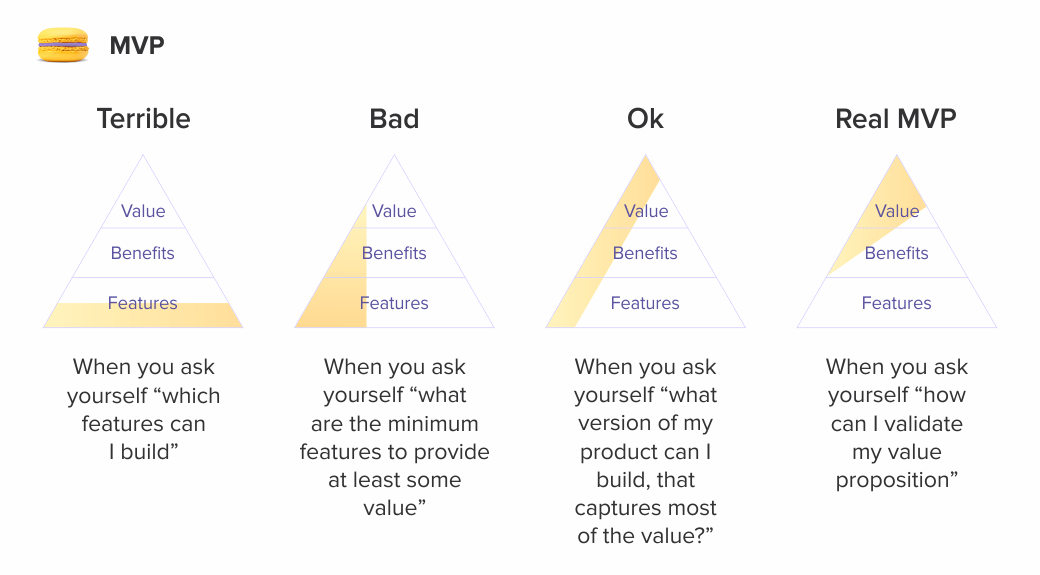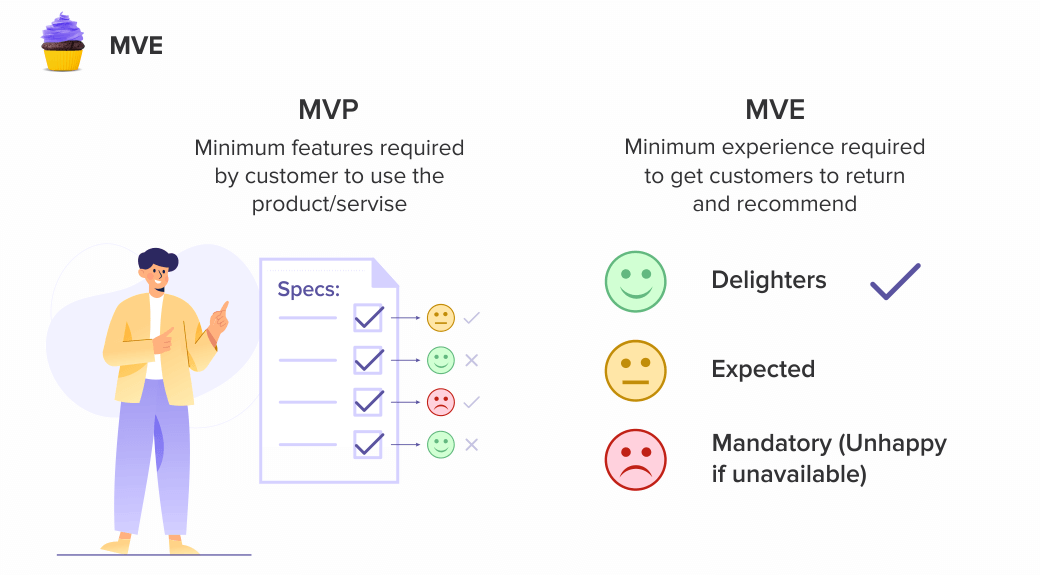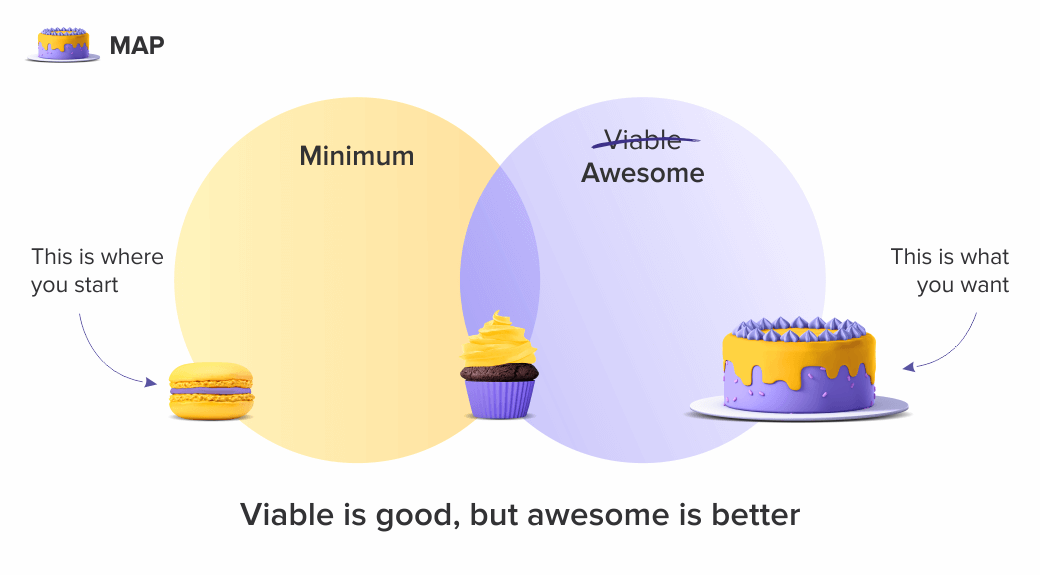Let’s put it this way, MVP is not dead and while we may use MAP as our goal for mobile and web app development, we need to understand when to use it. So, what is all the buzz about? Let’s figure it out together.
Nowadays the app market changes very quickly. Every day new apps are deployed, and users’ requirements on new products constantly increase. Today it’s not enough that the app is helpful. It also has to be easy-to-use, secure, fast and meet standards consumers are accustomed to.
Comparing MVP, MVE and MAP, we need to first learn what each of them is and how they should be used. All of these concepts belong to the Lean Startup methodology, however, there are certain differences.
What is a Minimum Viable Product (MVP)?

The minimum viable product (MVP) is a product with enough features to satisfy the initial customers and provide feedback for future development. An MVP gives enough understanding of your product potential at an early stage and at a lower cost compared to a fully-featured product.
Minimum viable product development can be the basis of the Build-Measure-Learn loop, a technique of testing a product idea before building the complete product. The Build-Measure-Learn loop tests the product hypothesis by building a small product, measuring the results it brings and learning from them. In the next iteration, the initial product can be either developed and updated, if the results were positive, or changed to a different idea, if the results proved to be negative.

Usually, the minimum viable product is a product built with the minimum feature scope at the minimum cost possible. Often, an MVP is released when there is no product at all. It can be a landing page with a subscription form, a manual service behind the scenes, or even a video describing the future product. Its main purpose is to get users' feedback. Therefore, the main benefits of building an MVP for a startup are:
Quick feedback. An MVP is built within the shortest time possible and starts generating data right after launch.
Ability to make a decision early on in the project. An MVP shows whether your product idea has been demanded or not, allowing you to decide to either push on or change direction while you still have not yet invested too much.
The base for future product development. When planning your MVP, note the features you discarded for this version of the product. You may add them later if you still think they are appropriate. At the same time, your users may suggest features they would like to see in a complete product.
What is a Minimum Viable Experience (MVE)?

Anyone with experience in Agile project development understands the importance of the MVP. At the same time, every entrepreneur should ask themselves: “What's the minimum experience I want for my customers when using a product and/or service?”
In short, an MVE is an MVP done right. In building an MVE, the focus is shifted from the features to the customer's experience, creating a more custom app development.
The MVE also serves the Build-Measure-Learn purpose, but, in this case, you are aiming to build a minimum usable product that gives your users an easy and intuitive experience. The idea is that customers care only about the way they experience your product or service.
When building an MVE, select the features that form a complete user experience and make sure that they work as close to perfect as possible. The features should create a full user journey, achieving the main goal of the product. When you choose the features, consider what customers may expect in a product of this kind and what they consider essential. Ideally, every goal that customers may wish to achieve should have a corresponding feature.
For example, if you are planning an AirBnB-like booking service, your MVE should enable the complete flow of booking a place and paying for it. It doesn't matter if you're calling the apartment’s owner on the phone behind the scenes – your customers won't know. At the same time, your MVE may lack social sharing functions, profile customization, and a loyalty program. These features are not critical for the business goal and can be added later.
If in the same example of booking service, you fail to include a booking confirmation feature, your MVE is going to fail. It may seem that you have built your product around the core feature – the booking engine – but the customer experience will be incomplete. You can hardly expect people to like the service when they never know whether their ride is confirmed or not.
The pros and cons of the MVE are mostly the same as those of the MVP. The main thing is to create an experience and learn from the customers' feedback about it.
What is a Minimum Awesome Product (MAP)?

This is another concept that is used in the software development process. MAP is an evolution of MVP and a way of preventing your MVP from being too “minimal”. Nowadays, users are already very UX-savvy, and are unwilling to explore a website with only a “Subscribe” button. However, this does not mean you should go to the other extreme and load your MVP with lots of fancy animations, images, videos, and other special effects.
A MAP is an MVP considered from the point of view of today's expectations of “minimal”. A small example: when building an MVP for a local tourist application, you can include a link to Booking, offering hotels in your region. You can format it as a text link or a clickable Booking logo. Which of the two will be more impressive to your users? That's a MAP for you.
The main distinction of a MAP when compared to an MVP and MVE is that the MAP may have a slightly wider set of features, and consider UI and UX design as well. As a result, MAP aims to develop a fully custom web application. When selecting the scope of your MAP, think of what users are accustomed to finding in applications of the same type. A better UI design may make the user believe that the application is more effective than one with a “barebones” design. Also, consider the way your competitors design their products. Yours should not look meager in comparison.
So, What Approach to Choose for App Development?
In fact, all three concepts that we have talked about are variations of the same thing – a product developed at a minimal cost to validate an idea. Deep down, the MVE and MAP are also MVPs, but made in the context of customers' current expectations and preferences.
If you opt to create an MVP in the form of a landing page or a video, you can hardly include a complete customer experience in it, but you can make it awesome. Create a striking landing page that can bring you lots of leads and will be bookmarked in your users' browsers.
The only case when you can go easy on the “awesome” is when you have absolutely no competition. When you are about to launch something that has never been offered before, your MVP can be equal to your MAP and be as minimal as you find practical. It will be your idea that is going to attract customers, and the design can wait until later.
Final Thoughts
No matter which approach you choose, the main thing is learning from the results. Do not feel disappointed or discouraged if your first product is rejected by users. You have learned early in the game, and that's the whole point of the “minimum product” model. Analyze the results and move on – either to modify your initial concept according to users' expectations, or to discard it altogether and pursue a completely different path. Your experiment has saved you a lot of time, effort, and money that would be better spent on another project.
If you have an application idea and want to test it, 2muchcoffee can help you build your minimum product. Our development team will deliver your MVP or MVE in the most cost-effective way and, of course, make it awesome. We will be glad to cooperate with you on transforming your idea into a real-life product.





